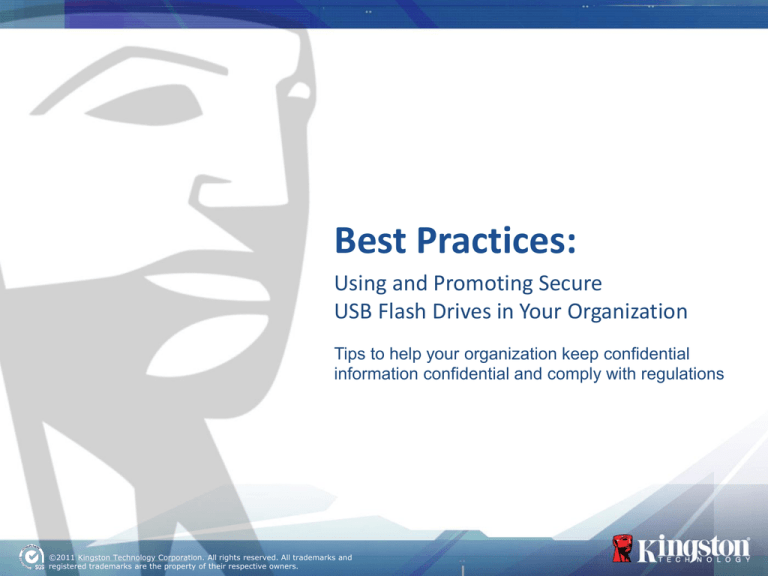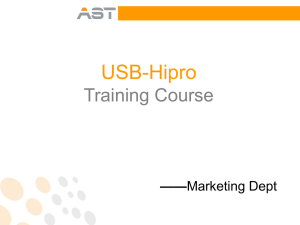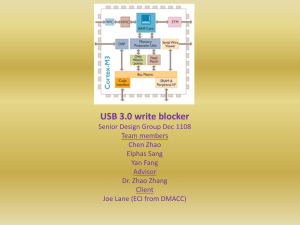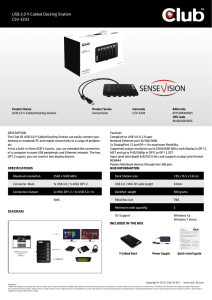
Best Practices:
Using and Promoting Secure
USB Flash Drives in Your Organization
Tips to help your organization keep confidential
information confidential and comply with regulations
©2011 Kingston Technology Corporation. All rights reserved. All trademarks and
registered trademarks are the property of their respective owners.
2
Build an Encrypted USB Plan: Protect & Comply
•
The best time to develop an encrypted USB plan is before you need to prove you
had one – incorporate secure USB Flash drives and policies into your organization’s
overall security strategy.
•
Have a contingency plan in place for recovering lost drives.
If you don’t have a plan in place for secure USBs and guidelines, you’ve got nothing to build
on and your organization is at risk at every level – including failure to comply with
regulations. Do a simple Google search on data loss involving non-secured USBs and you’ll
see organizations that did not have a solid plan.
3
Identify the Most Suitable
USB Flash Drives for Your Organization
Select the correct USB Flash drive that fits your organization’s needs. Recommended
actions would be to:
•Determine the reliability and integrity of USBs by confirming compliance with leading
security standards and ensuring that there is no malicious code on them.
•Understand the many options available that balance corporate needs for cost,
security and productivity. Ensure you have the right level of security for the right price.
If you don't need military-grade security, don't pay for it.
•Work with your purchasing department if you need to and get the support from
executive management.
If you don’t do your homework, your initiatives may by more challenging to implement and
difficult to justify. Simple analysis of what your organization needs and knowing there’s a
range of easy-to-use, cost-effective, secure USB Flash drive solutions can go a long way
toward enabling your organization, and your end users, to get a handle on the issue.
4
Train and Educate
Establish a training program that educates employees on acceptable and unacceptable
use of USB Flash drives.
•Walk users through actual breach incidents and other negative consequences that
occur when using non-secure USBs.
•Get HR and senior management involved to support your USB security initiatives. All
new employees should be trained as part of the company introduction.
•Create a trade-in-program. Engage employees by having them trade their personal
USBs or those that they use for business or as storage devices that were acquired at
trade shows, etc. for company-authorized USB drives.
If you don’t train and educate end users, you don’t have a tightly sealed data leak
prevention strategy and you’re more prone to be breached. A recent Ponemon USB security
study* found that 72% of employees use free drives from conferences and tradeshows,
business meetings, etc. – even in organizations that offer ‘approved’ USB options.
*Ponemon Institute Study www.kingston.com/secure/PDF_files/MKP_272_Ponemon_WP.pdf
5
Establish and Enforce Policies
Institute policies for the proper use of electronic portable storage media, including
USB Flash drives. Start by:
•Identifying those individuals and groups that need access to and/or download
sensitive and confidential data on secure USB drives, and set a policy that allows them
access.
•Documenting policies for IT teams and end users.
•Mandating that all employees attend training and sign an agreement post-training so
they understand the acceptable use policies and the implications of not following
guidelines.
If you don’t have the right policies in place for all to follow, USB drives can potentially be the
downfall of your data security strategy. Setting a policy is the first step, but it’s an incredibly
important one. Underscoring the need to establish and enforce USB policies, the Ponemon
study results revealed that nearly 50% of organizations confirmed having lost drives
containing sensitive or confidential information in the past 24 months.
6
Provide Company-Approved USBs
Provide employees with approved, encrypted USB Flash drives for use in the
workplace. Approved Flash drives should incorporate the following features:
•Proven hardware-based encryption using Advanced Encryption Standard (AES) 256.
Hardware-based security provides portability and superior encryption over host-based
software encryption.
•User storage space should be 100% encrypted. No non-secured storage space should
be provided.
•Hardware-based password authentication that limits the number of consecutive
wrong password attempts by locking the devices when maximum number of wrong
attempts is reached.
If you don’t provide secure USBs and implement policies that allow end users to be
productive, employees usually find a way to work around these security systems out
of necessity.
7
Manage Authorized USBs and Block Unapproved Devices
Use device-level management software to manage USB Flash storage devices.
Centralized device-level management software allows for drive control over LAN and
Internet connections and is an excellent tool for:
•Establishing and enforcing secure USB usage policies on an individual and/or group
basis.
•Auditing file activity to better track data moving in and out of your organization.
•Providing remote content backup for users who transport critical data.
•Remotely disabling devices when lost or compromised and remote password reset
when forgotten.
If you do not, sensitive data can be copied onto these devices and shared with outsiders
and your organization is the next statistic for data loss or theft.
8
Encrypt Confidential Data
•
To ensure that your data is safe, it should be encrypted before being sent out via
email or saved on removable storage devices.
•
For those organizations in which confidential or sensitive data is part of your
business such as financial, healthcare, government, etc. encryption is the most
trustworthy means of protection.
•
Following the above will provide a “safe harbor” from penalties related to data
loss disclosure regulations.
If you don’t encrypt data before it’s saved on USBs, hackers can bypass your anti-virus,
firewall or other controls, and that information is vulnerable.
9
Certify Anti-Virus Protection is Present at Every Entry Point
•
Ensure endpoint-host computer systems are equipped with up-to-date anti-virus
software.
•
Consideration should be given to software programs that provide protection
against malware on the USB device when used in non-corporate controlled PCs.
New threats emerge every hour or less, and can come from anywhere — email, websites
and removable media like USB drives and CDs. Up-to-date anti-virus software is critical for
keeping your network safe from known and unknown threats.
Tips provided by:







